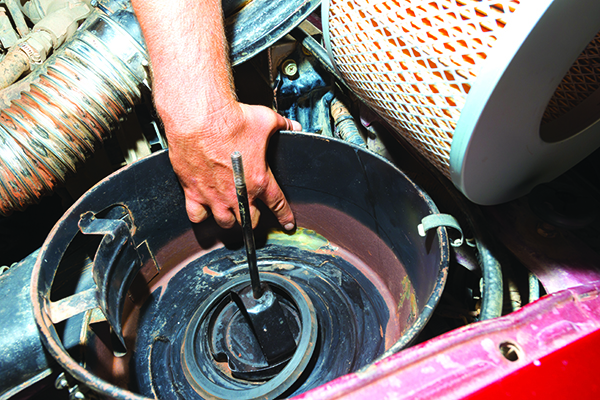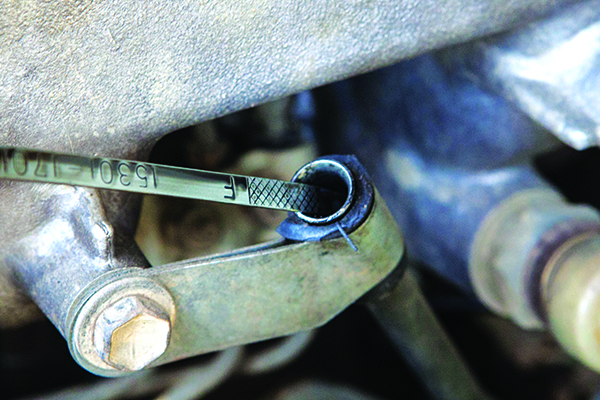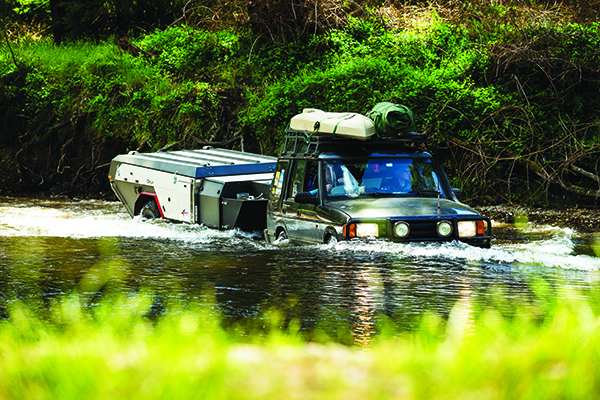Nothing says “offroad adventure” like dipping your tyres into a majestic water crossing. It gets the heart racing, and gives you the ultimate feeling of satisfaction as you climb out the other side; that’s IF you make it across, however! There’s a bit of an art in successfully crossing a river or a creek, and it’s an art worth mastering when you consider what’s at stake. Getting stuck could a quick recovery, a soggy story to tell, or an all-out nightmare!
When you think about it, how you handle a water crossing really comes down to two things – knowledge and judgement! But every river crossing is different, and with things like current flow, water levels and bank erosion constantly changing the game, you pretty much have to approach every crossing like it’s the first time, no matter how many times you’ve actually driven it in the past. But not to worry; we’ll give you the info you need to become a river crossing guru!







GET PREPARED: TRICKS OF THE TRADE THAT COULD SAVE YOUR SETUP
Seal it up: It should go without saying, anything you can do to protect against water penetration is time and money well spent! You can start by sealing up any gaps that let water get to where it shouldn’t. There are often little holes under the carpet of the vehicle’s cabin, and on the firewall, that should be sealed up. You’ll never get it 100 per cent watertight but it’ll help buy you time, which is exactly what you need when you’re stuck in the middle of a bloody river!
In the engine bay, look for anywhere water might be able to enter the engine. The engine oil dipstick should be nice and snug, the engine’s breather setup is worth checking out, and the air intake should definitely be 100 per cent watertight, preferably with a snorkel fitted.
If you’ve got an old petrol engine, you’ll want to keep water out of the engine’s electrical components, namely the distributer, coil and high tension leads. A high quality sealant will usually goes a long way, but it’s worth carrying a can of water displacement (like WD-40) to give it a spray with before diving in to it.
Also, store your parts like air and fuel filters in sealed plastic bags – the last thing you want is your spare parts getting wetter than the originals!
Do it on foot first: Walking the crossing first is usually a pretty smart option, providing it’s safe to do so. Remember, saltwater crocs up north are always up for a snack, so if you can’t explicitly see a safe line to cross from the shore, don’t do it! Same goes for causeways too, who’s to say it hasn’t collapsed mid-way through?
Fast flowing rivers can become a real danger. The problem is, it's easy to underestimate how powerful the water is, and a strong undercurrent can sweep the best of us away. Here’s a tip – If you can’t walk it with ease, you shouldn’t drive it! Plain and simple!
It makes sense for whoever gets to be the human water depth gauge to be an experienced 4WDer, too – you know, so they know what to look for. The obvious observation is the water’s depth, with a keen and thorough eye for any dips, low spots and holes. Rocks and boulders should be inspected with plenty of care, and the same goes for the amount of traction available.
After scouring the crossing by foot, pick the safest line to tackle and stick to it. Make sure the line allows for the increased turning circle with a trailer in tow, and has enough room to cater for a floating trailer if things get a little too aquatic! Oh, and make sure you’ve had a good look at the entry and exit point. These can change dramatically over time. In fact, up north you’ll find some crossings are unrecognisable after the wet season.
Keep your cool: Dipping hot metal in cool water is just a recipe for disaster, so before you dive into the deep end, it’s a good idea to stop and let your vehicle cool down a bit. There are a few reasons for this, the first being to reduce the likelihood of things like your brake assembly steaming up or, even worse, getting distorted, warped, brittle or damaged! Also, the rapid change in temperature affects how well your hub seals can do their job, too.
Your engine’s coolant temperature is another one to watch. If a cooling fan is active when it’s submerged in water, it can bend the fins to the point it impacts the radiator. For viscous-coupled fans, make sure it’s cool enough to rotate it freely by hand – they’re designed to lock up to the engine when it’s hot. If your vehicle has a thermostatic electric fan, make sure it’s not active when you cross either. In fact, it’s a good idea to keep you’re air-conditioning system switched off, too, as it can activate the cooling fan when the air-con condenser gets hot.
TIME TO GET WET
Okay, so you’ve walked the crossing and planned the best possible line to take. The engine’s nice and cool, your water bra is secured in place and it’s time to get stuck into it! Guess what? It’s all up to you now! It goes without saying; you’ll want to select 4WD and low-range gears. Why low range? It’ll give you maximum engine torque to push through the water, and give you more control over engine rpm and vehicle speed. If you’ve got lockers, use them – you just can’t have too much traction!
Despite what you see on TV and in photos, you’ll want to avoid having water spraying all over the place. Instead, go for a speed that allows a nice and gentle bow-wave to form in front, which helps lower the water level in the engine bay.
Another tip is to avoid changing gear while you’re in the water; water can get between the clutch assemblies components, which rely heavily on friction to work properly.
Gear selection: The last thing you want is for the engine to stall mid-way through a water crossing. Not only will you stop moving and allow water to enter inside, your engine also risks sucking water back up through the exhaust pipe, especially for low clearance vehicles. If you do get stuck, try and keep the engine running with enough revs to push the water out the exhaust.
The correct gear selection goes a long way to preventing the engine from stalling. You’ll want a gear that offers enough speed to create a nice little bow wave, yet enough torque to push through the water without relying on pure vehicle speed, especially if it’s a bouncy, rocky river bottom.
If the engine does stall, try and start it up instantly, unless you think there could be water in the engine. In which case is would be advised not to restart the engine to avoid internal damage.
That floating feeling: When a 4WD starts to float, it’s always a cause for concern. If wheels don’t touch the ground, you lose control and traction, and that’s when anything can happen – after all, a 4WD is not a boat. Sure, a floating 4WD can actually come in pretty useful at times but, make no mistake, it’s a dicey situation to be in. There’s always the risk of tipping over, or getting carried away downstream. Obviously, weight plays a bit of a role here; the heavier you are the less buoyant your setup is. For us camper trailer owners, it’s usually the trailer that begins to float first, which can wind up dragging the whole vehicle downstream if there’s a decent current.
Believe it or not, some trailers (like box trailers) can be better off being submerged if the water crossing is deep and there’s nothing valuable inside the tub – purely to add weight! But that’s up to you.




